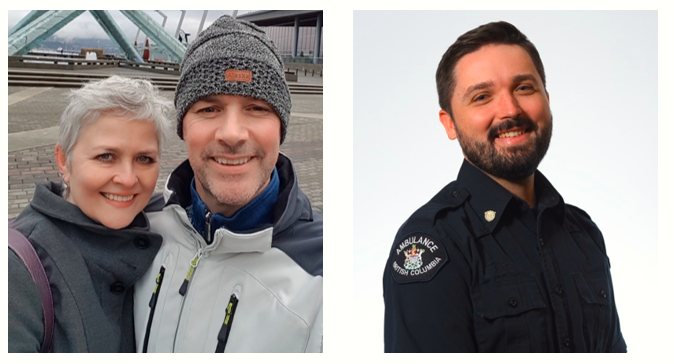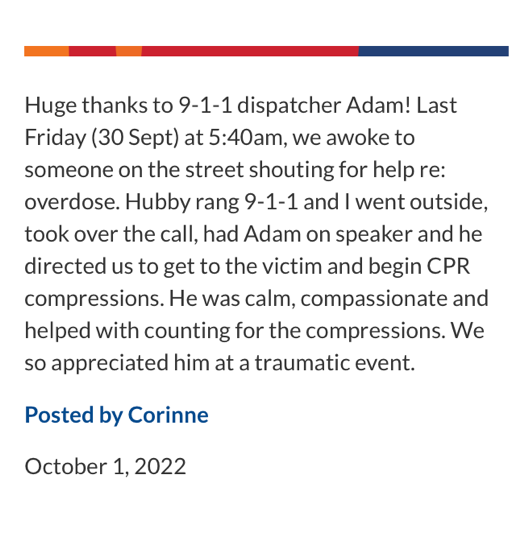When Corinne and her husband, Dom, woke to yelling outside their Victoria home, they had no idea what to expect when they called 9-1-1. Noise on their street isn’t uncommon, but Corinne says this felt different.
“There was such urgency in the woman’s voice. She was yelling for someone to call an ambulance – there was an overdose, she didn’t have a phone,” recalls Corinne.
Adam Nataros picked up as the emergency medical call-taker. “I'll always remember this call for the way a complete stranger so willingly sprang into action without hesitation to help another stranger,” says Adam.
With Adam on the phone asking questions, Corinne and Dom gathered from the woman outside that one of their neighbours had experienced an overdose.
Corinne says she was surprised by how many questions Adam initially asked, but Adam explains this is typical for all calls.
“When you call 9-1-1, we need to collect some key information. Please be ready to provide your location and answer some additional questions,” says Adam. “This helps us provide the best care possible and does not delay the ambulance.”
Adam says Corinne stands out in his memory as an engaged caller who was willing to help. “She also established a personal connection with me early on by asking me for my name and introducing herself. I think that humanized a hectic moment and made her feel more comfortable jumping into action to help a stranger. It definitely felt like we were working as a team.”

9-1-1 callers Corinne and Dom worked as a team with their emergency medical call-taker, Adam
Adam explained help was on the way, but asked if Corinne and Dom felt safe going inside their neighbour’s apartment to learn more and potentially help in the meantime.
“When possible, having a caller physically with the patient is hugely helpful as an emergency medical call-taker and ideal for patient care, especially when time is of the essence,” explains Adam.
Corinne said she felt initially hesitant, but she and Dom quickly decided they wanted to do everything they could to help. “Once we got inside, he was lying on the bed, looking like he was sleeping,” says Corinne.
Adam explained they’d have to move the patient onto the floor before they could start CPR. Then, Dom started chest compressions, with Adam counting and Corinne holding the phone on speaker. Within minutes, first responder firefighters arrived to take over medical care, followed almost immediately by an ambulance crew and police officers.
Corinne and Dom gave their statements and went home. “Only then did we realize how much adrenaline we’d had – we’d been outside in our pajamas and slippers, and hadn’t even noticed how chilly it was!”
“As traumatic as the whole thing was, we would absolutely do the same thing again – although I hope we never have to!" says Corinne. "We know we did everything we could have at the time, as fast as we could have.”
 “Through everything, Adam always emphasized only doing what we felt safe and comfortable doing,” recalls Corinne. “We wanted to help – and Adam made us feel completely supported, but never pressured.”
“Through everything, Adam always emphasized only doing what we felt safe and comfortable doing,” recalls Corinne. “We wanted to help – and Adam made us feel completely supported, but never pressured.”
Corinne sent a message of thanks – a meaningful and special opportunity for Adam to hear the impact of his work. Out of thousands of calls, he rarely gets to learn the patient outcome or see the lasting impression he’s made on callers like Corinne and Dom.
“Emergency medical call-takers never know what situation the next call will throw them into. They range from the tender and beautiful to the hostile, abusive, tragic,” says Adam. “We jump into a stranger's world for all of a few minutes in order to help them.”
Adam says this call serves as a powerful example of how 9-1-1 callers can help.
“On these difficult calls, I always try and separate what was in my control versus what wasn’t. Neither myself or Corinne had any control over the many factors that may have led to the patient overdosing, or how long they may have been down for” says Adam. “What I can do is gather information so that we're sending the right resources and coach a caller to help the patient. Knowing that both myself and the caller did everything possible for this patient in the situation we were faced with puts me at peace and allows me to move on; I hope it does for Corinne, too.”
For others who find themselves in a similar situation, Adam says it’s important for callers to understand how important bystander CPR and use of an automated external defibrillator (AED) can be in emergency situations. “By taking immediate action, the chance of survival can double or triple. The instructions we give for CPR, or any other intervention, do not require any previous medical training and we will walk you through each step.”
Adam says this particular call also emphasizes a tragic reality of the drug toxicity crisis. In 2022, 83 per cent of fatal overdoses in B.C. occurred inside, mostly in private residences where people use alone.
“I would urge anyone who uses drugs to use the free
Lifeguard app which is designed to automatically call 9-1-1 if somebody overdoses and nobody else is there or able to phone for help,” says Adam. “I have personally taken a call where a life was saved with Lifeguard, and I know it has saved dozens of others.”
Adam started with BCEHS as an emergency medical call-taker (EMCT) over three years ago, and has since became an emergency medical dispatcher.
EMCTs answer inbound 9-1-1 calls, gather critical information from the caller and use approved protocols and systems to assess the patients. Emergency medical dispatchers then use this information to determine the appropriate emergency response team or ambulance to send to the scene. While paramedic crews are enroute, dispatchers pass along essential information that will help them care for the patient when they arrive.
More than half a million 9-1-1 calls each year get routed to ambulances, which are answered by EMCTs and dispatchers like Adam, working closely with partner agencies such as police, fire, search and rescue and coast guard to ensure that British Columbians have access to timely and effective care.
“I enjoy being part of a team dedicated to working around-the-clock to help people on their worst day,” says Adam. “There’s a lot of satisfaction that comes from collaborating to overcome challenges whether they be operational/staffing issues, a hard to access or locate patient, or seeing the room come together seamlessly for those ‘big calls.’ I'm lucky to work with a team that is also very supportive of one another.”
Emergency Service Dispatchers’ and 9-1-1 Awareness Week from April 9 to 15 recently celebrated the emergency medical call-takers and dispatchers who help form the backbone of B.C.’s emergency response system:
Please join us in recognizing our emergency medical call-takers and dispatchers year-round by sending a message of thanks if one of them has made a difference in your life or the life of someone you love.

